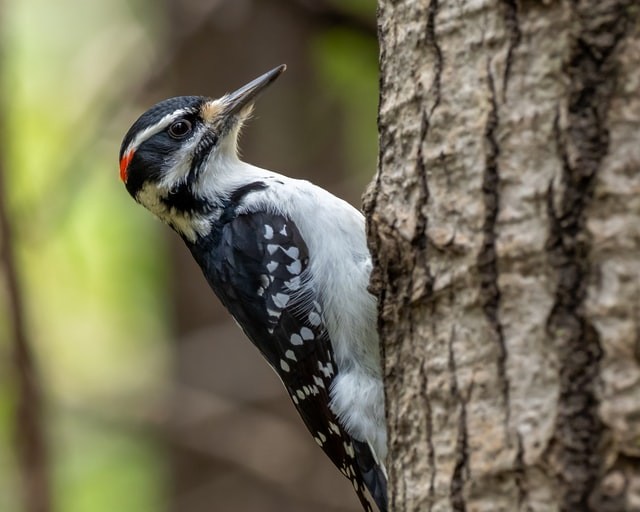How woodpeckers can continuously strike tree trunks with their beaks without harming their brains has long been a mystery to scientists.
Because of this, it was assumed that their skulls must function as shock-absorbing helmets.
Now, scientists disagree, claiming that their heads function more like stiff hammers. Their calculations really reveal that any stress absorption would interfere with the woodpeckers' ability to peck.
The hard skull of woodpeckers
 (Photo : Patrice Bouchard)
(Photo : Patrice Bouchard)

According to Sam Van Wassenbergh of the Universiteit Antwerpen in Belgium, "we discovered that woodpeckers do not absorb the shock of the hit with the tree" after studying high-speed films of three species of woodpeckers, as per ScienceDaily.
First, Van Wassenbergh and associates calculated the effects of pecking decelerations in three different woodpecker species.
They built biomechanical models using the data and came to the conclusion that any stress absorption in the skull would be harmful to the birds.
Do their brains suffer damage from the ferocious pecking if their skulls don't serve as shock absorbers? In actuality, it doesn't.
The deceleration stress associated with each peck surpasses the accepted threshold for concussion in humans and primates, yet the smaller brains of woodpeckers can sustain it.
According to Van Wassenbergh, woodpeckers are capable of making mistakes, such as when they peck metal with all of their might.
But even without the protection of their skulls functioning as protective helmets, their normal pecking on tree trunks is often considerably below the threshold to produce a concussion.
The lack of shock absorption does not indicate that their brains are in danger during the ostensibly strong blows.
Given that our calculations revealed brain loadings that are lower than those experienced by people who have suffered a concussion, even the biggest shocks from the more than 100 pecks that were examined should still be safe for the woodpeckers' brains.
According to Van Wassenbergh, the results disproved the long-held hypothesis of shock absorption, which has gained popularity in the media, literature, zoos, and other places.
Also Read: Animal Evolution: Helmeted Woodpecker Mimics Its Larger Competition
Unusual skull bone and tongue bone structures
The experts found that woodpeckers had impact-absorbing characteristics that other birds do not have by comparing the skulls of woodpeckers and chickens, as per The Conversation.
Specialized skull bones, neck muscles, beaks, and tongue bones are among them.
The chemical makeup and density of the skull bones are distinct.
For instance, one structural adaptation involves boosting the mineral deposition in the bones, which results in bones that are stiffer and stronger than those of other birds.
Interestingly, the skull bone is quite thin, and less fluid than in other birds and animals separates the brain from the skull bone. This would imply that the skull has evolved to be both harder and tougher.
In real-world materials research, hardness and toughness are typically traded off in some way.
However, less impact is transmitted to the brain when the skull is covered with both hard and strong materials.
Another distinction is that compared to other large mammals, woodpeckers have less internal fluid around the brain.
This lessens the amount that the brain can move while being picked.
When opposed to a raw, uncooked egg yolk, which will be harmed by shaking, the reduced amount of fluid has an impact similar to that of a hard-boiled egg yolk.
A bone that is included in the tongue of woodpeckers aids in the removal of insects from trees.
A dense coating of compact bone encased a porous, spongy bone, giving it the rigidity and strength of a conventional skeletal bone.
The tongue bone of the woodpecker, however, is constructed differently, with a flexible sheath and a firmer core bone.
Higher impacts and vibrations may be absorbed by this inside-out arrangement, which also offers improved flexibility.
A dense coating of compact bone encased a porous, spongy bone, giving it the rigidity and strength of a conventional skeletal bone.
The tongue bone of the woodpecker, however, is constructed differently, with a flexible sheath and a firmer core bone.
Higher impacts and vibrations may be absorbed by this inside-out arrangement, which also offers improved flexibility.
Related article: Ivory-Billed Woodpecker, Several Other Birds and Fishes Declared Extinct by U.S. Government
© 2024 NatureWorldNews.com All rights reserved. Do not reproduce without permission.





